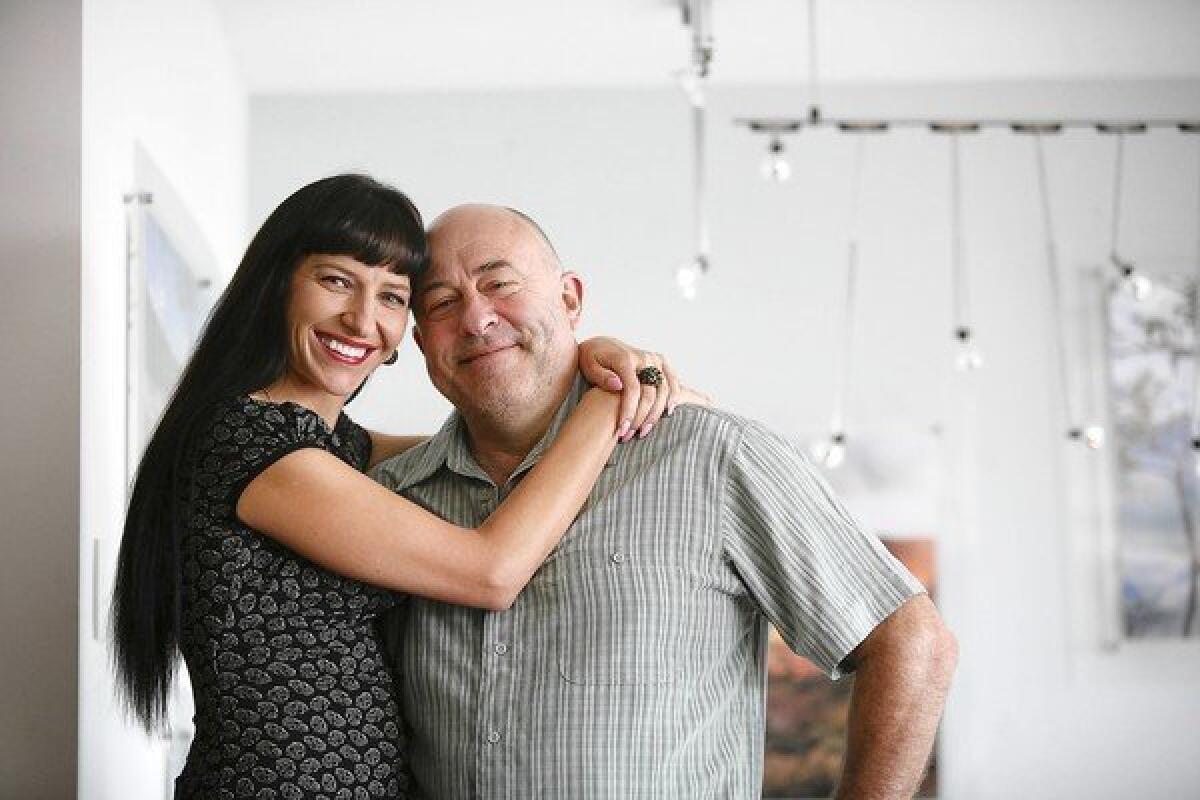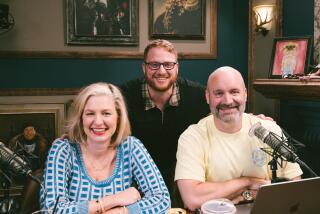Moozfly an unorthodox Web platform for Spanish-speaking comedians

Anna Nikita Doroshina, described as a Russian Martha Stewart, was the inspiration for Moozfly, an online comedy channel that features Spanish-speaking comedians from around the world.
That might seem odd â because it is.
But almost everything about Moozfly is unorthodox. Its studios are located in a 3,300-square-foot Rancho Palos Verdes home overlooking the Pacific Ocean. The executive director, a linguist from Colombia, joined the company after answering a Craigslist ad. And the brains behind the venture is Doroshinaâs 56-year-old husband, a discouraged land developer who was looking for something new.
PHOTOS: Celebrities by the Times
Serge Doroshin came up with the concept for a Spanish-language video site because of a boom in Latino media and decided to pursue comedy because, he said, âcomedy is always relevant.â
His interest in the Internet was piqued by the Web success of his wifeâs Russian-language cooking and travel videos. If that many Russian women were viewing Doroshinaâs homemaking lessons â including many who have limited Internet service â then what would stop young Latinos from flocking to a Web-based Comedy Central-like channel?
âEverybody is hungry for content,â Doroshin said. âNo one else has what weâve started here â Spanish-speaking comedians delivering topical humor.â
More than two dozen comedians have joined Moozfly, which launched last month. Comedians from Spain, Mexico, the U.S., Costa Rica, Argentina and Australia have contributed material.
In one feature, a Colombian soap opera actress mocks the frothy Spanish-language soaps that are wildly popular in Latin America. In another, a Spanish actress plays a former madame who gives relationship advice. In a third, a Los Angeles member of a comedy troupe called the Hot Tamales riffs on celebrity news as the siteâs gossip girl.
âFor me, this is a dream come true,â said comedian Miguel Bugni during in a recent interview, via Skype, from his home in Madrid.
Bugni, who was born in Argentina and spent time in the U.S. (he learned English at Santa Monica City College), and had been working at comedy clubs and making the occasional TV appearance. He uploaded videos of his monologues to YouTube, where some drew more than 100,000 views.
But Moozfly has given him the opportunity to go beyond stand-up to create material for the Internet. At a production studio in Madrid, Bugni prepares satirical âMooz Newzâ segments in which his âMiky McPhantomâ character is a pugnacious TV news anchor similar to Comedy Centralâs Stephen Colbert.
âA lot of my humor is politically incorrect, and you canât do that in a lot of countries,â Bugni said. âThis project is giving me the opportunity to develop my comedy for people in the U.S. and around the world.â
Moozfly is one example of media entrepreneurs and major U.S. media companies gearing up programming to woo Latinos, one of the nationâs fastest-growing demographic groups.
Last summer News Corp. introduced the Spanish-language broadcast network MundoFox. Spanish-language media giant Univision Communications Inc. and ABC News plan to launch a 24-hour cable-TV news channel to appeal to English-speaking Latinos next year, and recently set up a website to provide election news. Last spring former NBC programming executive Ben Silverman started a YouTube channel featuring Spanish-speaking comedians called NuevOn.
Advertisers are watching.
âIt used to take hundreds of millions of dollars to launch a network or cable channel, but now you can launch a channel if you have a good idea and can create compelling content for an audience that is underserved,â said Chet Fenster, managing director of MEC Entertainment, which specializes in ad strategies.
âFor these niche programming services, it really is: âIf you build it, they will come,â â Fenster said. âThatâs the mentality of some of these programmers, and they probably are not that far off.â
Doroshin was born in Argentina and grew up in Canada and New York. Over the years, he has dabbled in numerous ventures including licensing South American movies for video rentals, selling childrenâs vitamins in the Soviet Union during the Cold War, and more recently, buying real estate and trying to develop housing communities in Riverside and San Bernardino counties.
But the Internet is the new frontier. Doroshin hopes his small staff in L.A. can use technology to help Moozflyâs roster of comedians around the world produce high-quality, funny videos that will attract ad dollars or lend themselves to syndication sales. He plans to use the Moozfly site as a platform to offer downloads of stand-up routines of the comedians, modeled after comedian Louis C.K.âs successful venture this spring selling views of his act for $5 a pop.
âThe idea of Moozfly was to put the best comedians together on one page,â said Paula Henao, executive director of the venture.
Doroshin speaks very little Spanish. He met the Spanish-speaking Henao, originally from Colombia, after she answered an online ad and hired her to coordinate social media campaigns. Now she is recruiting and coordinating the logistics with comedians.
Doroshin declined to say how much he is investing in Moozfly. But his plan is to keep the videos exclusive to his own site, rather than funnel them through YouTube. Heâd rather cut out Google Inc., which owns YouTube, so his company and the comedians can divide the advertising revenue generated by their videos.
âThe great challenge of the Internet is monetization,â Doroshin said. âWeâre trying to create a community of comedians where everyone can share in the profit.â
However, Doroshin recognizes that the search company is a force, calling Google âthe 800-pound gorilla.â He has gone back and forth on whether to let YouTube distribute his wifeâs lifestyle videos to increase their exposure and reach.
Doroshina said the name of her Russian program âNashkotyolâ could be translated as âour melting pot.â Segments include Martha Stewart-style how-to lessons in cooking and decorating, with an occasional travel piece to venues around L.A. Occasionally, some of the coupleâs six children appear.
Most segments are shot in the Rancho Palos Verdes home, which is next door to the familyâs primary residence. The second home serves as temporary studios for Moozfly and its small staff. Recently on the market for $1.725 million, the four-bedroom house was one of Doroshinâs investments.
The entrepreneur is convinced that the new site will take off.
âWe need original content thatâs excellent, and we do have comedians who already have an audience,â Doroshin said. âBut we need to build the audience â thatâs the trick. Itâs not a question of do we succeed, but rather to what degree do we succeed?â
MORE:
INTERACTIVE: TVs highest paid stars
PHOTOS: Hollywood back lot moments
More to Read
Inside the business of entertainment
The Wide Shot brings you news, analysis and insights on everything from streaming wars to production â and what it all means for the future.
You may occasionally receive promotional content from the Los Angeles Times.











